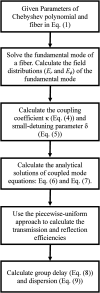Chebyshev apodized fiber Bragg gratings
- PMID: 35510898
- PMCID: PMC10450710
- DOI: 10.1177/00368504221094173
Chebyshev apodized fiber Bragg gratings
Abstract
In this paper, a new apodized fiber Bragg grating (FBG) structure, the Chebyshev apodization, is proposed. The Chebyshev polynomial distribution has been widely used for the optimal design of antennas and filters, but it has not been used for designing FBGs. Unlike the function of traditional Gaussian-apodized FBGs, the Chebyshev polynomial is a discrete function. We demonstrate a new methodology for designing Chebyshev-apodized FBGs: the grating region is divided by discrete n sections with uniform gratings, while the index change is used to express the Chebyshev polynomial. We analyze the Chebyshev-apodized FBGs by using coupled mode theory and the piecewise-uniform approach. The reflection spectrum and the dispersion of Chebyshev-apodized FBGs are calculated and compared with those of Gaussian FBGs. Moreover, a sidelobe suppression level (SSL), a parameter of the Chebyshev polynomial, along with the maximum ac-index change of FBGs are analyzed. Assume that the grating length is 20mm, SSL is 100 dB, the section number is 40, and the maximum ac-index change is 2 × 10-4. The reflection spectrum of Chebyshev apodized FBGs shows flattened sidelobes with an absolute SSL of -95.9 dB (corresponding to SSL=100 dB). The simulation results reveal that at the same full width at half maximum, the Chebyshev FBGs have lower sidelobe suppression than the Gaussian FBGs, but their dispersion is similar. We demonstrate the potential of using Chebyshev-apodized FBGs in optical filters, dispersion compensators, and sensors; Chebyshev apodization can be applied in the design of periodic dielectric waveguides.
Keywords: Chebyshev polynomial; Fiber bragg gratings; bragg reflectors; optical fiber devices; optical fiber filters.
Conflict of interest statement
The author(s) declared no potential conflicts of interest with respect to the research, authorship, and/or publication of this article.
Figures











References
-
- Erdogan T. Fiber grating Spectra. J Lightwave Technol 1997; 15: 1277–1294.
-
- Chiang JS, Chang HY, Sun NH, et al.High sensitive two-dimension tilted-meter based on chirped fiber Bragg gratings. IEEE Sensors J 2016; 16: 8477–8482.
LinkOut - more resources
Full Text Sources
Miscellaneous

